
...but the best
songs 'n years in this story are yet to come...
....and they are coming NOW....
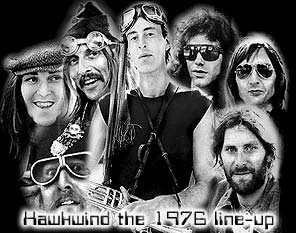
clockwise:
| Nik Turner * Simon King * Dave Brock | ||
| Robert Calvert | ||
| Simon House * Alan Powell * Paul Rudolph |
![]()
1975/76
saw the return of Calvert to the ranks of the
band. After a guesting at Hawkwind's Reading gig in 1975 Calvert joined
the band once more - this time as their full time lead-vocalist
and frontman - and this should cause an immediate change in the
band's musical style and appearance...
![]() Being in his preferred / natural position as frontman and entertainer,
Calvert introduces an even stronger poetical
and theatrical influence to the recordings and especially the band's
performances.
The
Atomhenge
model, used throughout the 1976/77 tours, is a gigantically extended molecular
model - looking, according to it's name like a mixture of Brussel's Atomium
and Stonehenge.
Being in his preferred / natural position as frontman and entertainer,
Calvert introduces an even stronger poetical
and theatrical influence to the recordings and especially the band's
performances.
The
Atomhenge
model, used throughout the 1976/77 tours, is a gigantically extended molecular
model - looking, according to it's name like a mixture of Brussel's Atomium
and Stonehenge.
Designed by Larry Smart (of 'Exploding Galaxy') and Hawkwind's reknown lighting and stage-design wizard Jonathan Smeeton - (better known with his company of helping hands as Liquid Len and the Lensmen), Atomhenge stretches over the entire stage and serves at the same time as a projection element.
![]() This stage set-up -
combined with Calvert's elaborate performances
turned Hawkwind's performances far over the edge of anything considered
to be 'just' another ordinary rock concert - their gigs turned in fact
into a fully-fledged rock
theatre.
This stage set-up -
combined with Calvert's elaborate performances
turned Hawkwind's performances far over the edge of anything considered
to be 'just' another ordinary rock concert - their gigs turned in fact
into a fully-fledged rock
theatre.
A type of performance in which Calvert could integrate his numerous talents:
songwriting, singing, directing, acting, improvising - and entertaining.
Calvert:
"It
all works up to a nice piece of spontaneous theatre. lt's great to be
able to improvise something like that at at the drop of a hat. Rock is
a very theatrical thing, what with body language, gesture, movement, mime
and the like.
Although we're steadily getting into more theatre we're very wary about
it becoming too contrived. In some way, it must grow out of the music."
Calvert soon gained recognition for his talent for improvisation, his rock-entertainment style and the eccentricity and theatricality of his shows.
He created performances for various songs using countless props and costumes - the most famous of these is probably his Steppenwolf performance - appearing with top hat, a frock-coat and walking stick, carrying some chains around his neck...
![]() "Robert
Calvert is a most compelling onstage figure.
"Robert
Calvert is a most compelling onstage figure.
During Steppenwolf he dresses in a very sinsiter fashion with black coat,
black top hat, even - or so it appeared - a blacked out face. Later in
the set he abandons the sombre image and adopts a sword-fighter's role,
brandishing swords and battling with unseen foes."
[
Read an extensive article on a typical Hawkwind performance
in 1976 HERE
and / or HERE
]
[
Read 8
Days a Week - a one week diary by Calvert, orig. published in the
MELODY MAKER, Oct. '76 - a brief & witty insight into the time preceeding
the Atomhenge '76 tour.]
For Calvert the spontaneity of the shows was always an important aspect
- he used the stageshows also as a kind of laboratory to live out and
experiment with the characters he invented in his lyrics and to experiment
with the ideas and imagery that currently preoccupied him.
A lot of ideas and inspirations came from books that Calvert was reading by the time - which subsequently turned into lyrics and stageshows - like in the case of H. Hesse's Steppenwolf.
|
>
LISTEN
to Calvert
talking about his inpirations drawn from books and his obsessive way of working < |
He always worked
in an 'obsessive way' and everything that was 'currently in front of his
senses' could turn into the act - often reappearing onstage in the fusion
of seemingly strange or exotic characters:
"The
main character I play is someone called Aubrey Dawney. He's a sort
of 1914-1918 fighter ace, plus a bit more. Mick
Farren described him as being a cross between Biggles, and
Lawrence Of Arabia -, which he is, he has connections with the Far
East and also Opium smoking."
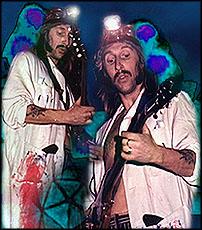
|
"Visually
Hawkwind are the mutations you know and ove. |
![]() But Calvert did not
only 'revamp' Hawkwind's 'image' and performances. By writing all the
band's lyrics
and co-composing almost every song, he changed Hawkwind's musical style
dramatically.
But Calvert did not
only 'revamp' Hawkwind's 'image' and performances. By writing all the
band's lyrics
and co-composing almost every song, he changed Hawkwind's musical style
dramatically.
But, at this stage the group consisted of 7 members - big ego's amongst them... obviously too many wanna-be captains on board...
...still, they went on to produce some...
![]()
![]()
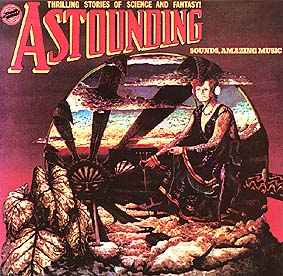
Amazing
Music 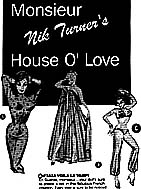
- the first and only
album this line-up has recorded, gathers a strange and somewhat incoherent
mixture of styles due to the fact that almost every member delieverd a
song. Consequently the quality of the entire album is quite varied - still,
it contains two all-time Hawkwind highlights: the fascinating Steppenwolf
- featuring some of the the best lyrics Calvert ever wrote - and the paranoid
and driving Reefer
Madness.
Both songs are Calvert / Brock collaborations - pointing the way to Hawkwind's
new energetic and original style.
![]()
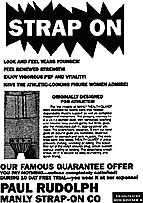
Keeping up with the
inventiveness of Brock & Calvert's songwriting was (again) the cover
design and concept, featuring yet another sleeve by the late & great
Barney
Bubbles, one
of the UK's
outstanding and most influential designers, and a wonderful quirky
and surreal painting by Calvert's friend Tony
Hyde in the style of early SF pulp magazines.

![]() The inner sleeve accordingly consisted of an assemblage of faked adverts
offering the most dubious services of the band members:
The inner sleeve accordingly consisted of an assemblage of faked adverts
offering the most dubious services of the band members:
![]()
![]() an invitation to Monsieur
Nik Turner's Love House,
an invitation to Monsieur
Nik Turner's Love House,
Paul Rudolph's Manly-Strap-On-Underwear,
Mr. Calvert's He-Man-Voice-Institute....
However, the power struggles lying ahead were probably inevitable...
 "Rudolph
and Powell were blamed by me and Brock for trying to introduce a funky
style. Well, funky music and Reggae
were two styles I was never very fond of..."
"Rudolph
and Powell were blamed by me and Brock for trying to introduce a funky
style. Well, funky music and Reggae
were two styles I was never very fond of..."
In another interview
Dave Brock said that both he and Calvert felt that musical and commercial
'corruption' was creeping in. So, in a sort of 'Stalinistic
purge', as Calvert put it, Paul
Rudolph, Allan Powell and even the long
time member Nik
Turner were shown the door by Brock and Calvert - now sharing control
over the motherboard.
| HERE you can read another interview with Calvert and Dave Brock from 1977 - shortly after the split of the 'Astounding...' line-up. |
| HERE's another article on Hawkwind & an interview w. Calvert on the litetary and theatrical characteristics of his / their work |
 However
harsh this process must have been - the co-captains apparently did the
right thing. With Adrian
Shaw as the only new member being drafted in on bass the line
up got tighter - and musically by far more effective - now being able
to develop their entire virtuosity and experimental
/ innovative abilities.
However
harsh this process must have been - the co-captains apparently did the
right thing. With Adrian
Shaw as the only new member being drafted in on bass the line
up got tighter - and musically by far more effective - now being able
to develop their entire virtuosity and experimental
/ innovative abilities.
So, when probably most of the music-biz already saw Hawkwind as a dead
man walking, the new line-up balanced out a perfect musical chemistry,
set out to explore new territories - and in 1977 delievered
the band's
musical milestone and all-time
Meisterwerk

![]()
 Charged
with energy, a daring modern approach and some of the most imaginative
- in fact far ahead of their time -
lyrics ever written in rock - music, QUARK...
is not only on the height of it's time - it became a distinctive precursor
and strong
influence for a lot of upcoming Punk & New Wave bands ...
Charged
with energy, a daring modern approach and some of the most imaginative
- in fact far ahead of their time -
lyrics ever written in rock - music, QUARK...
is not only on the height of it's time - it became a distinctive precursor
and strong
influence for a lot of upcoming Punk & New Wave bands ...

![]() ...though they probably would've never admitted
it then.... -
...though they probably would've never admitted
it then.... -
with some rare ekseptions to proof it - as no other than The
Clash's Joe Strummer, one of the heralds of Punk, cited Hawkwind
as a major influence when talking about The Clash's first record:
'I wanted
to do a Hawkwind version of a song that was familiar to us, and we just
did it within our limitations'.


![]() While all members deliever
outstanding performances, Calvert keeps pushing his poetical and conceptual
preoccupations. The subjects of his lyrics range from new
technologies (genetics/cloning) / post-nuclear
wastelands / the threat
of Islamic fundamentalism / an ambiguous review of the lost and commercialised
Days of the Underground
to the subtle ironies of Quark,
Strangeness and Charm.
While all members deliever
outstanding performances, Calvert keeps pushing his poetical and conceptual
preoccupations. The subjects of his lyrics range from new
technologies (genetics/cloning) / post-nuclear
wastelands / the threat
of Islamic fundamentalism / an ambiguous review of the lost and commercialised
Days of the Underground
to the subtle ironies of Quark,
Strangeness and Charm.
Calvert on Hawkwind and the current music
of 1977:
"Hawkwind
is an experimental group at a time when rock music is very conventional;
very conservative. That's the thing that puzzles me about the "New Wave".
It's produced by kids who grown up with the media at their disposal and
yet still their view of the world is so old-fashioned.
Their political ideals seem to be based on really outdated ways of thinking;
influenced by George Orwell. They still believe that a 1930`s vision of
the future applies for our time. (more...)
-- sounds familiar, nowadays as well, doesn't it?
![]()
![]()
 Eventually the band made it's second TV appearance
on Marc Bolan's show to play the album's title track.
Eventually the band made it's second TV appearance
on Marc Bolan's show to play the album's title track.
> Calvert
on QUARK:
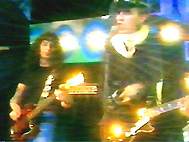 "QUARK...
is one of the few albums available at the moment which is very much in
touch with the modern world, and Hawkwind is a band which has always been
in touch with the modern world. The title itself is an expression of modern
physics terminology ... The album contains a selection of musical and
poetical interpretations of the world we live in, including the threat,
not only of nuclear war, but the threat of the Middle East becoming a
very powerful influence on
the future of this globe (...)."
"QUARK...
is one of the few albums available at the moment which is very much in
touch with the modern world, and Hawkwind is a band which has always been
in touch with the modern world. The title itself is an expression of modern
physics terminology ... The album contains a selection of musical and
poetical interpretations of the world we live in, including the threat,
not only of nuclear war, but the threat of the Middle East becoming a
very powerful influence on
the future of this globe (...)."
With QUARK...
the band finally receives the long overdue critical acclaim.
The Melody Maker even chose Quark,
Strangeness and Charm as the single of the month.
| READ a review of QUARK from the NME, July 1977. |
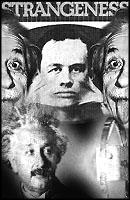
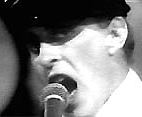 'Quark'
neatly showcased all the ingredients of the genre hailed as 'power pop'
two years later by the music media. Musically and melodically it was almost
a blueprint for the like of the Buzzcocks, Undertones and Skids in the late
70's. Lyrically,
it left each of them at the starting post - containing subtle humorous
lyrics, with Mr. Calvert's tongue firmly in cheek.'
'Quark'
neatly showcased all the ingredients of the genre hailed as 'power pop'
two years later by the music media. Musically and melodically it was almost
a blueprint for the like of the Buzzcocks, Undertones and Skids in the late
70's. Lyrically,
it left each of them at the starting post - containing subtle humorous
lyrics, with Mr. Calvert's tongue firmly in cheek.'The new line-up did their first 'Spirit of the Age' tour through the U.K. and delievered the best Hawkwind performances ever - accompanied again by a lavish stage show - greeted by both the audience and the press with enthusiasm:
'Wind of
Change' is a brilliant multi-media creation
and says a lot very economically. Liquid Len's silhouette projections
tell the tale of civilisation's development from a lone tree to space
city and all the way back down again while the band develop from a simple
bass pattern to majestic chording on guitar and Hammond.'
![]()
![]() The
set consisted mostly of the recent material with Calvert slipping into
even more different stage-characters. The Steppenwolf
transformed into the mad drugged-out oriental assassin to become the frantic
pseudo military advisor who delievered the Sonic
Attack warning.
The
set consisted mostly of the recent material with Calvert slipping into
even more different stage-characters. The Steppenwolf
transformed into the mad drugged-out oriental assassin to become the frantic
pseudo military advisor who delievered the Sonic
Attack warning.
![]() Calvert completely dissolved into those characters, creating an evergrowing
intensity - but apart from embracing the audience with a
full-scale theatrical performance this constant personality-switching
again led to problems in Calvert's very own psyche, that built up the
longer the tours went on.
Calvert completely dissolved into those characters, creating an evergrowing
intensity - but apart from embracing the audience with a
full-scale theatrical performance this constant personality-switching
again led to problems in Calvert's very own psyche, that built up the
longer the tours went on.
The
U.K. tour, however, went down very well - but the next one, leading the
band over the European continent, followed closely and now Calvert gradually
changed more and more into his stage-personae's.
Just one example of Calvert's increasingly manic phases
is the '(in)famous' Hawkwind in Paris episode,
where, near the end of the tour, Calvert finally went over the top.
![]() it's recommended that
you read
it's recommended that
you read
![]() the whole story in
Calvert's own words
before you proceed...
the whole story in
Calvert's own words
before you proceed...
![]()
![]()
![]() However
funny this episode might read, it merely scratches the surface of Calvert's
massive mental problems. According to Jeff Dexter,
Hawkwind's road manager at the time, at this very gig Calvert was under
the impression that the whole audience consisted of folks willing to organize
an underground / guerilla revolution - under his very own leadership,
of course.
However
funny this episode might read, it merely scratches the surface of Calvert's
massive mental problems. According to Jeff Dexter,
Hawkwind's road manager at the time, at this very gig Calvert was under
the impression that the whole audience consisted of folks willing to organize
an underground / guerilla revolution - under his very own leadership,
of course.
![]()
Throughout the entire tour Calvert read books on 'How
to set up your own private army' and other guerilla
war-fare antics. He read all those books in the long nights he couldn't
get to sleep - he was a chronical insomniac,
often staying
up for 5 or 6 successive nights.
Later on, Calvert even exchanged his machinge-gun stage prop for a real
one, travelling the whole tour in his stage-outfit - a
combat suit, complete with gas pistol
on his hip...
![]()
 ...all
this happening in 1977, the peak of European terrorist
movements... and the longer the tours went on, the more problems
Calvert apparently had to distinguish between his on and off-stage
personae(s). ...all
this happening in 1977, the peak of European terrorist
movements... and the longer the tours went on, the more problems
Calvert apparently had to distinguish between his on and off-stage
personae(s). However, all this apparently didn't spoil the actual performance - Read an NME review of the gig in Paris. After the Paris-incident the rest of the European tour-dates were blown out and Jeff Dexter, being left by the other band members with the horrifying task of taking care of Mr. Calvert and bringing him back to London, went through a nightmarish time... |
||
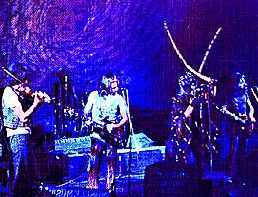 For
simply suggesting to drive back to the hotel Calvert chased him with
another of his stage-props: the sword he used during the
Hassan I Sahba / Assassins of Allah song.
For
simply suggesting to drive back to the hotel Calvert chased him with
another of his stage-props: the sword he used during the
Hassan I Sahba / Assassins of Allah song. Dexter in fear of his very life, finally blew him over the head with a large piece of solid wood. Although this had the desired physical effect, the impression on Calvert didn't last too long. The next day he even threatened Dexter with his gun when suspecting he'd be taken to a mental hospital - but... eventually Dexter got him to the airport... |
||
...still, the nightmare wasn't over yet for poor Jeff, as Calvert's paranoia was playing up again: all planes were booked out and the longer they had to wait the more Calvert became suspicious of some sort of conspiracy to kill him while being on the plane.
He spent the hours marching up and down the hall, refusing to drink or eat.
Dexter finally managed to talk the airport people into letting them on the next available plane - before a real catastrophe would be on their hands...
However, Calvert wasn't unaware of his own manic periods - arriving back in London he signed himself (again) to mental treatment and...
for their next album the tension grew again...
...yes, more troubles ahead - and more good music, after all...
...read about more split-up's and even more Hawkwind incarnations in
of the gripping & final episode of the Calvert-Collab-Relations story with HAWKWIND:
from Sonic Assassination to the Dead End

